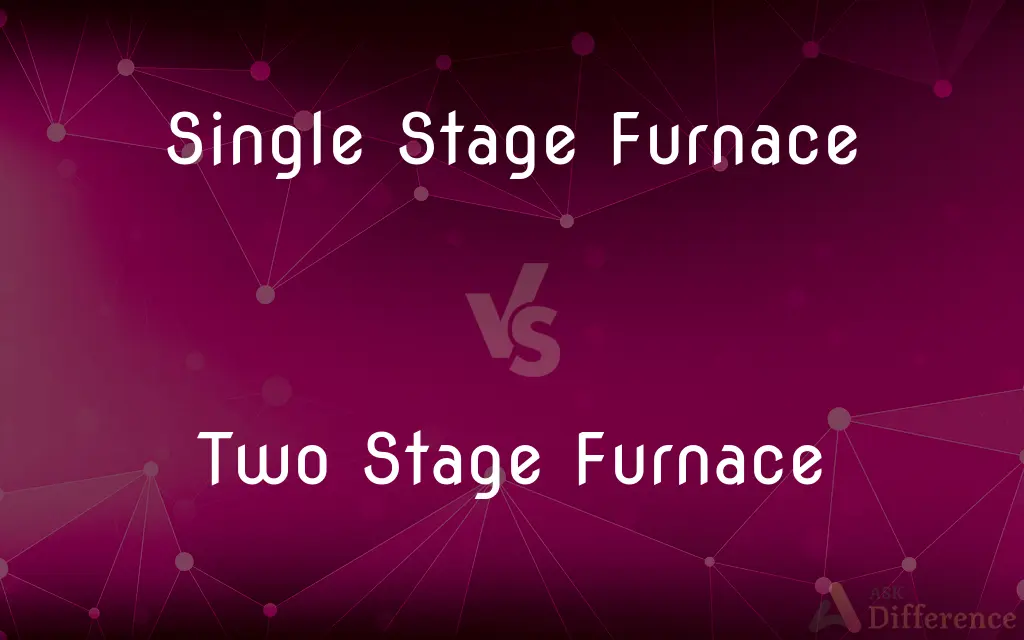Single Stage Furnace vs. Two Stage Furnace — What's the Difference?
Edited by Tayyaba Rehman — By Fiza Rafique — Published on March 3, 2024
A single-stage furnace operates at full capacity whenever it's on, providing a consistent level of heat. A two-stage furnace can adjust its output between a lower and a higher setting, offering more efficiency and comfort.

Difference Between Single Stage Furnace and Two Stage Furnace
Table of Contents
ADVERTISEMENT
Key Differences
Single-stage furnaces are known for their simplicity and cost-effectiveness. They have one operational mode: full blast. This means whenever the furnace is on, it operates at its maximum capacity until the desired temperature is reached, then shuts off. This all-or-nothing approach can lead to noticeable fluctuations in temperature and can be less energy-efficient, as it uses the same amount of fuel regardless of the actual heating demand. Two-stage furnaces, by contrast, are designed to offer more nuanced control over heating, with the ability to operate at a lower capacity during milder conditions and switch to a higher setting in colder weather.
The two-stage furnace's ability to adjust its output results in a more consistent indoor temperature, as it can run longer at a lower stage, reducing the temperature swings common with single-stage models. This not only enhances comfort but can also improve energy efficiency, as running at a lower stage consumes less fuel. Moreover, the longer, slower heating cycles of the two-stage furnace can lead to better air filtration and humidity control within the home, contributing to a healthier indoor environment.
In terms of cost, single-stage furnaces are generally less expensive upfront than their two-stage counterparts. However, the potential savings on energy bills with a two-stage furnace can offset the initial higher investment over time. Additionally, two-stage furnaces tend to operate more quietly, especially when running in the lower stage, since the blower and burner are not always at full capacity.
The choice between a single-stage and a two-stage furnace often comes down to balancing initial costs against long-term benefits. For those living in climates with mild winters, a single-stage furnace might suffice. However, for homeowners in areas with significant temperature variations and those prioritizing comfort and energy efficiency, investing in a two-stage furnace could be the more advantageous option.
Maintenance and lifespan considerations are similar for both types of furnaces, though two-stage furnaces might have slightly more complex components due to their adjustable functionality. Proper installation and regular maintenance are crucial for both to ensure they operate efficiently and last as long as possible.
ADVERTISEMENT
Comparison Chart
Operation Mode
Full capacity only
Low and high capacity
Temperature Control
Less consistent, with possible fluctuations
More consistent, with minimal fluctuations
Energy Efficiency
Less efficient, always uses full power
More efficient, adjusts power based on need
Initial Cost
Generally lower
Higher due to advanced technology
Comfort Level
Can lead to uneven heating
Provides even heating and improved air quality
Noise Level
Potentially louder due to full-capacity operation
Quieter, especially at lower capacity
Ideal Climate
Mild winters
Varied or cold climates
Compare with Definitions
Single Stage Furnace
Suitable for areas with mild temperature variations.
In their mild climate, a single-stage furnace met their heating needs efficiently.
Two Stage Furnace
More energy-efficient by matching heating demand.
Their energy bills decreased thanks to the two-stage furnace's efficient operation.
Single Stage Furnace
Generally less expensive and simpler in design.
They chose a single-stage furnace for its lower upfront cost.
Two Stage Furnace
Provides a more consistent indoor temperature.
With the two-stage furnace, every room stayed at a steady, comfortable temperature.
Single Stage Furnace
May result in less consistent indoor comfort.
The single-stage furnace made some rooms too hot and others too cold.
Two Stage Furnace
Higher initial cost but can offer long-term savings.
The two-stage furnace was an investment that paid off in comfort and savings.
Single Stage Furnace
Operates only at full power, turning on and off to maintain temperature.
The single-stage furnace quickly heated the room but caused noticeable temperature swings.
Two Stage Furnace
Quieter operation, especially on the low setting.
The two-stage furnace ran so quietly, they hardly noticed it was on.
Single Stage Furnace
Can be less energy-efficient due to constant full capacity operation.
Their single-stage furnace used more gas, reflecting in higher winter bills.
Two Stage Furnace
Can adjust its heating output to two levels, improving comfort.
The two-stage furnace kept the house comfortably warm without abrupt changes.
Common Curiosities
How does a two-stage furnace improve air quality?
By running longer cycles at a lower speed, a two-stage furnace can more effectively filter and humidify the home's air, improving air quality.
Can a single-stage furnace efficiently heat a home?
Yes, a single-stage furnace can efficiently heat a home, especially in regions with mild winters or less severe temperature fluctuations.
How long do two-stage furnaces last compared to single-stage?
With proper maintenance, both types of furnaces can have comparable lifespans, often ranging between 15 to 20 years or more.
Will a two-stage furnace always operate on the lower stage?
A two-stage furnace operates on the lower stage when heating demands are lower, switching to the higher stage in colder conditions to maintain comfort.
Can I replace a single-stage furnace with a two-stage furnace?
Yes, you can upgrade from a single-stage to a two-stage furnace, but it may require some adjustments to your home's ductwork and thermostat system.
Do two-stage furnaces require more maintenance?
While they may have more complex components, the maintenance requirements for two-stage furnaces are generally similar to those of single-stage furnaces.
Is a two-stage furnace worth the extra cost?
For many, the increased comfort, energy efficiency, and potential heating bill savings make a two-stage furnace a worthwhile investment.
Does the installation cost differ between single-stage and two-stage furnaces?
The installation cost can be higher for two-stage furnaces due to their more complex design and installation requirements.
How do I decide which furnace type is right for my home?
Consider your climate, comfort preferences, budget, and long-term savings potential. Consulting with a heating professional can also help determine the best option for your needs.
Are two-stage furnaces bigger than single-stage furnaces?
The physical size of the furnace depends more on its heating capacity than its stage type, though two-stage furnaces may have additional components.
Share Your Discovery

Previous Comparison
Bearded Dragon vs. Fancy Bearded Dragon
Next Comparison
Micro SDHC vs. Micro SDXCAuthor Spotlight
Written by
Fiza RafiqueFiza Rafique is a skilled content writer at AskDifference.com, where she meticulously refines and enhances written pieces. Drawing from her vast editorial expertise, Fiza ensures clarity, accuracy, and precision in every article. Passionate about language, she continually seeks to elevate the quality of content for readers worldwide.
Edited by
Tayyaba RehmanTayyaba Rehman is a distinguished writer, currently serving as a primary contributor to askdifference.com. As a researcher in semantics and etymology, Tayyaba's passion for the complexity of languages and their distinctions has found a perfect home on the platform. Tayyaba delves into the intricacies of language, distinguishing between commonly confused words and phrases, thereby providing clarity for readers worldwide.
















































